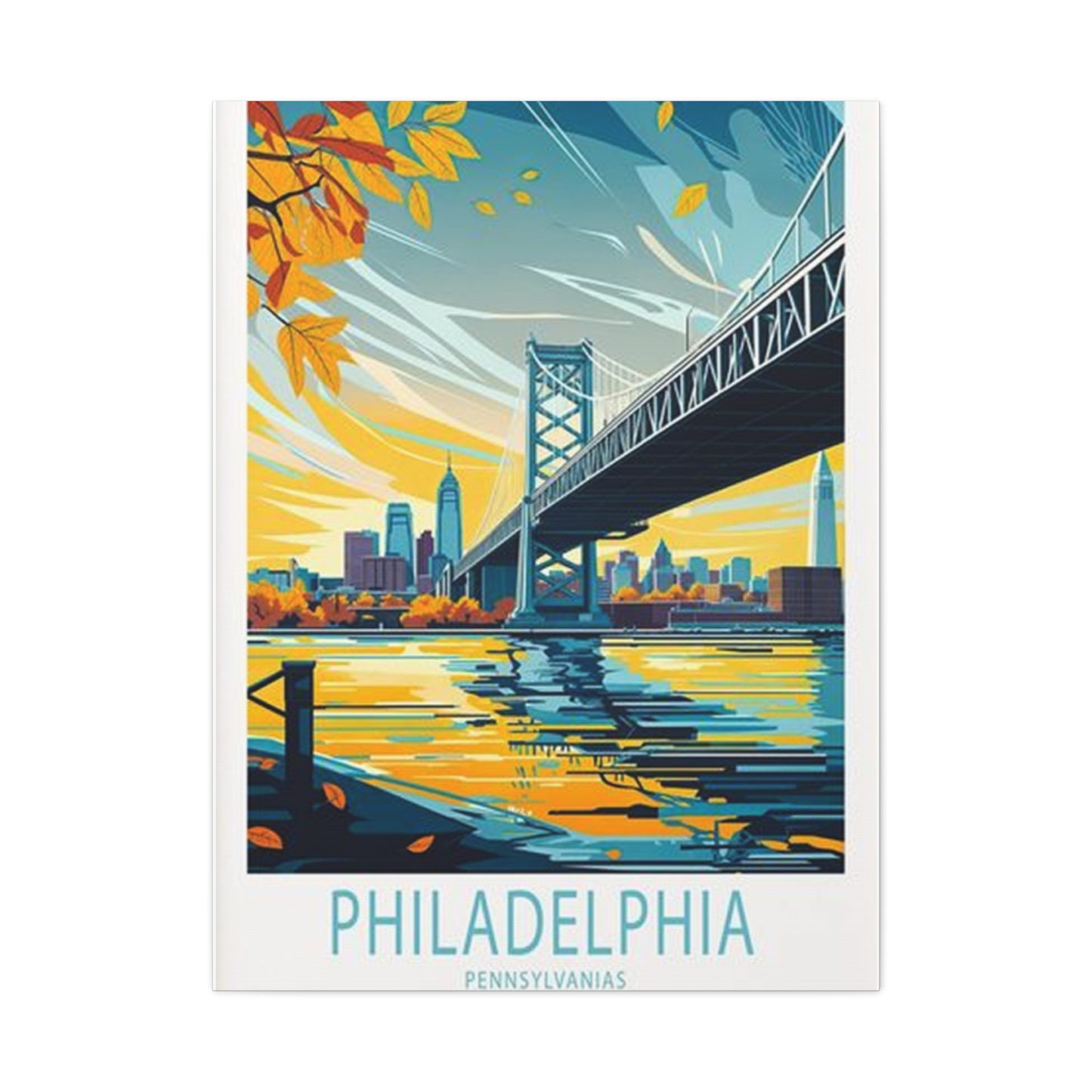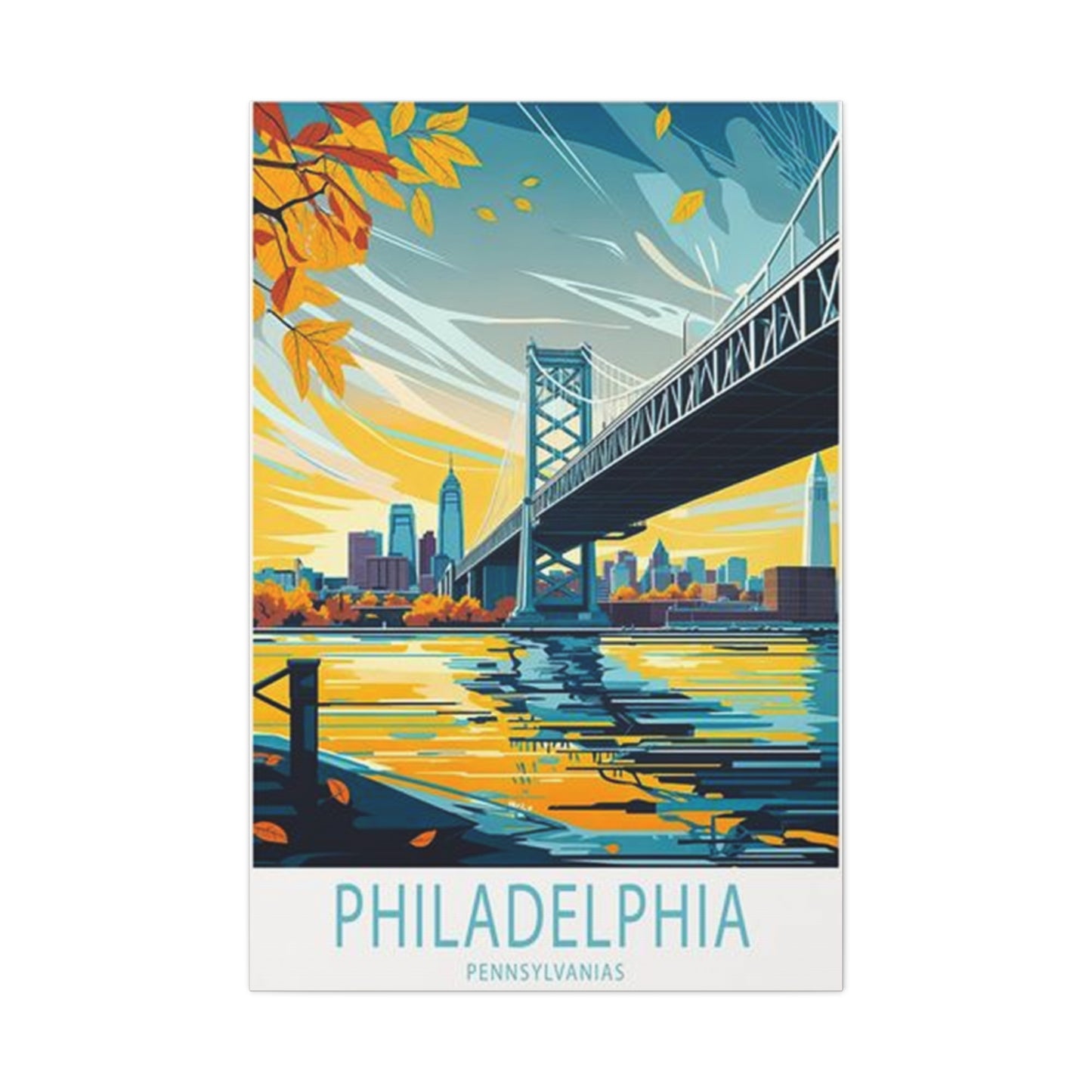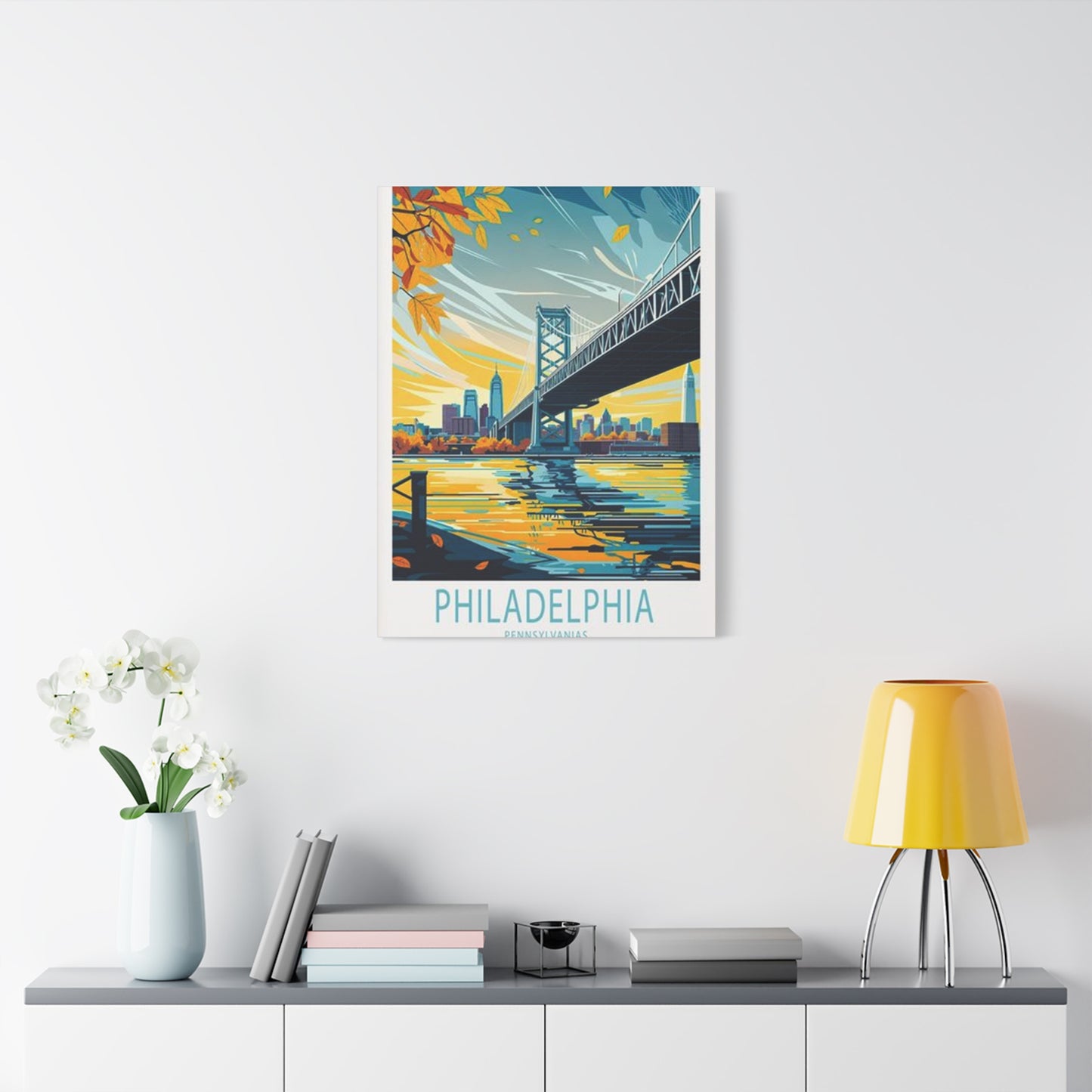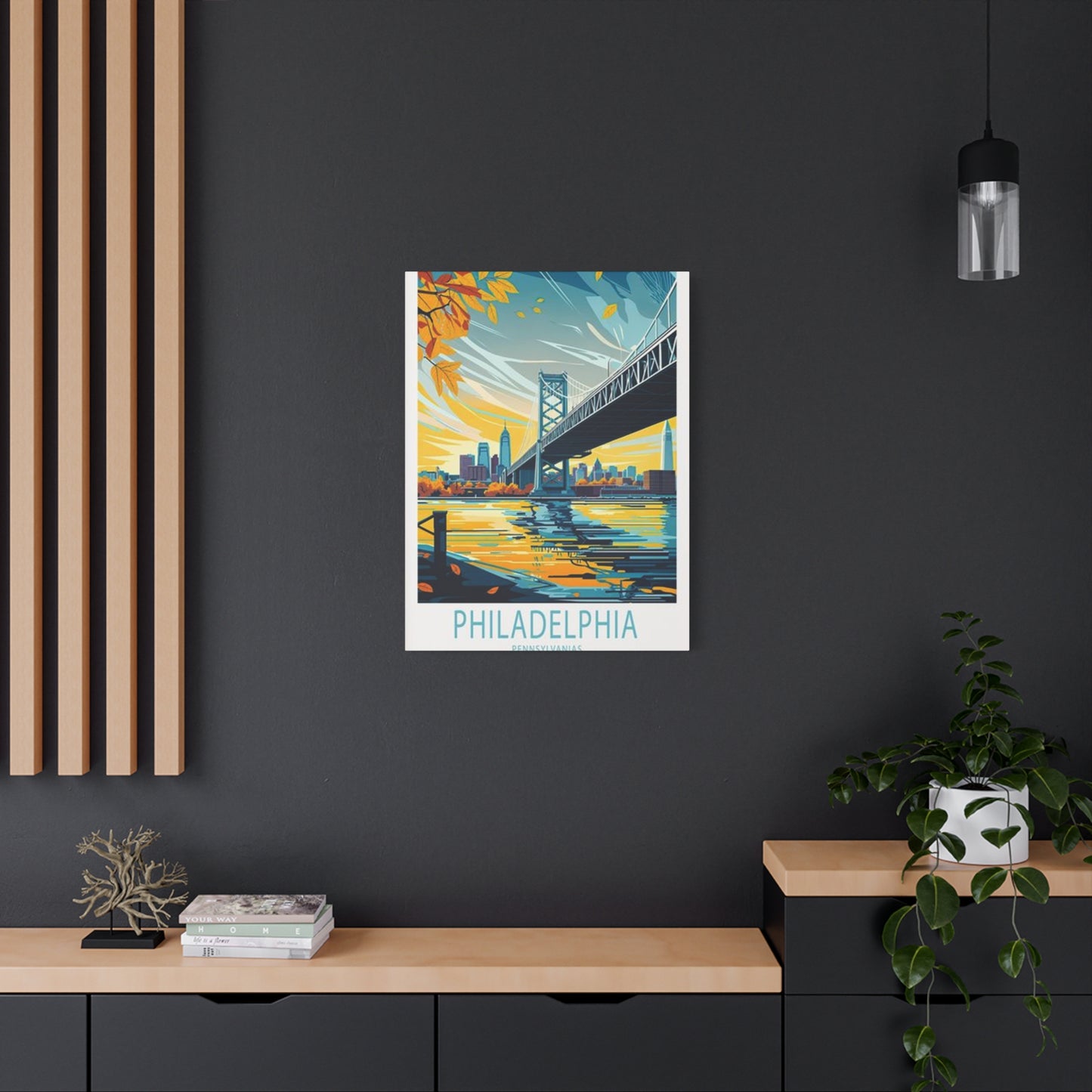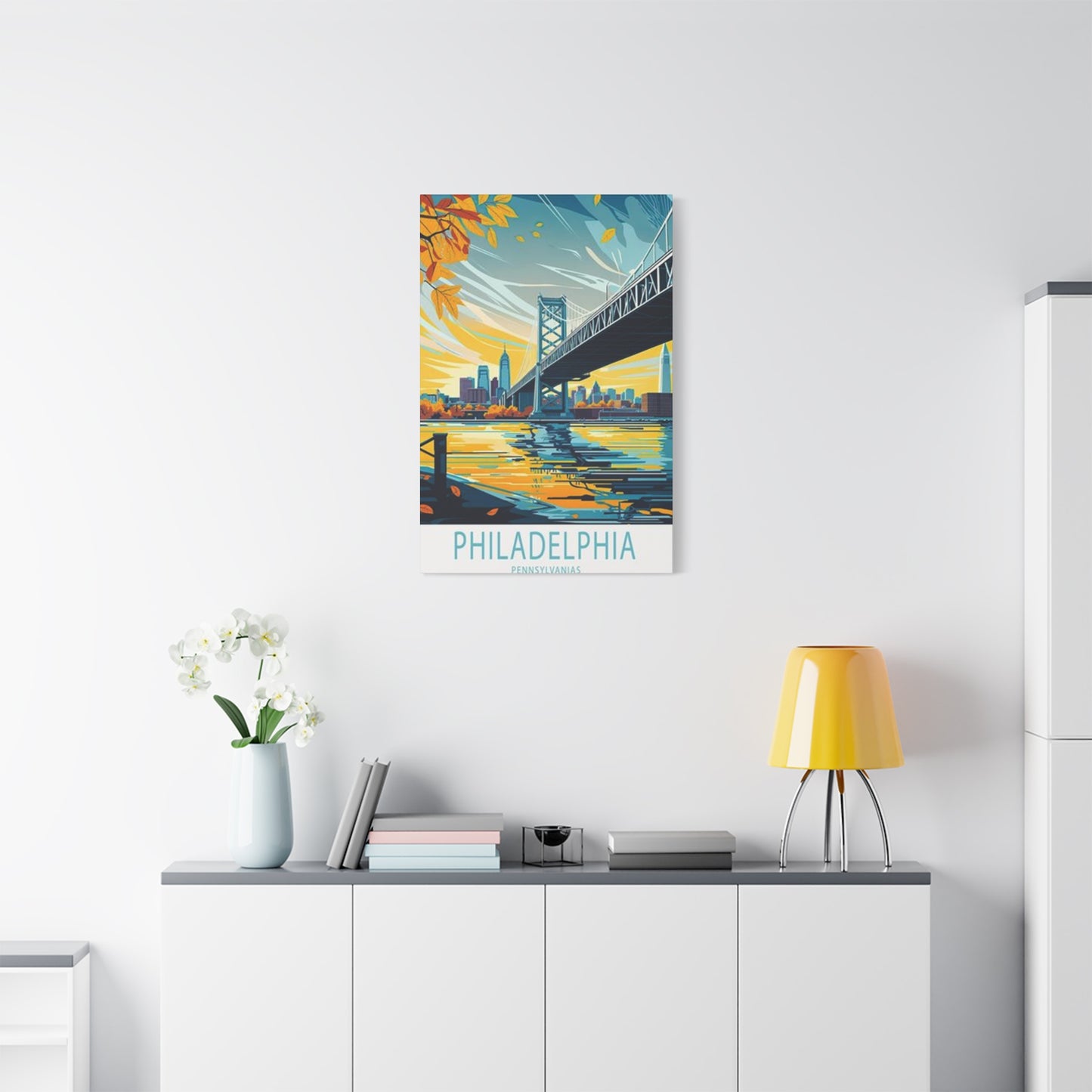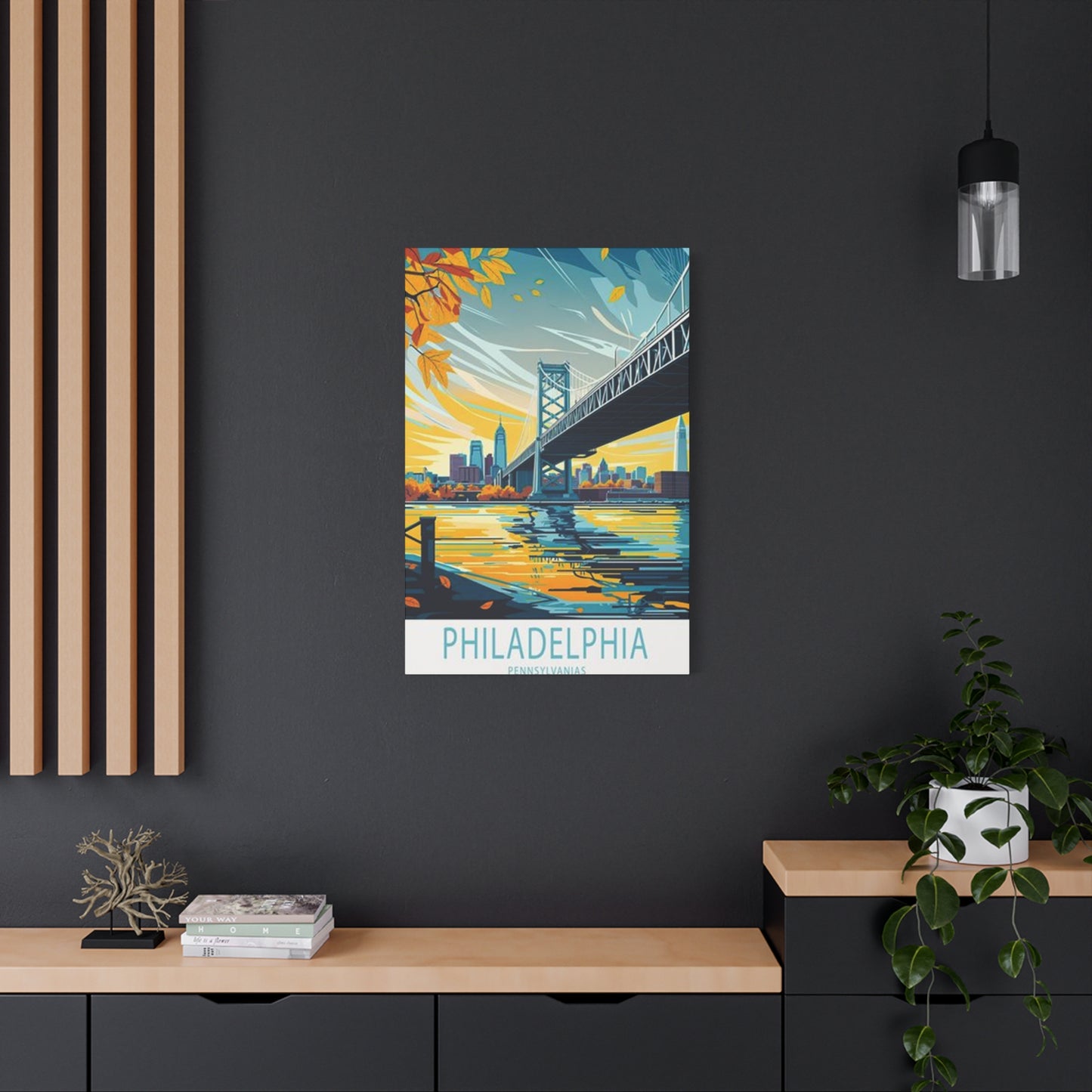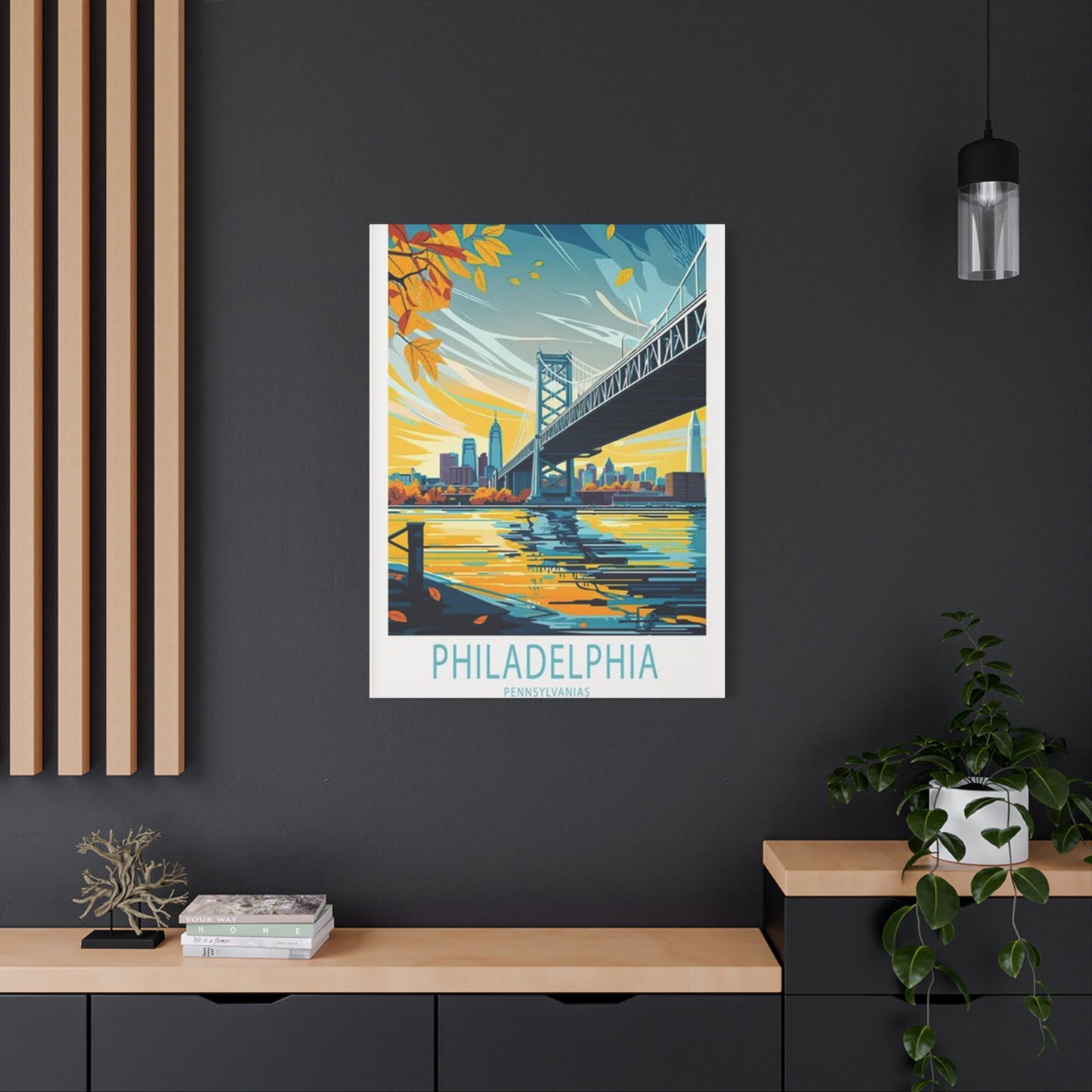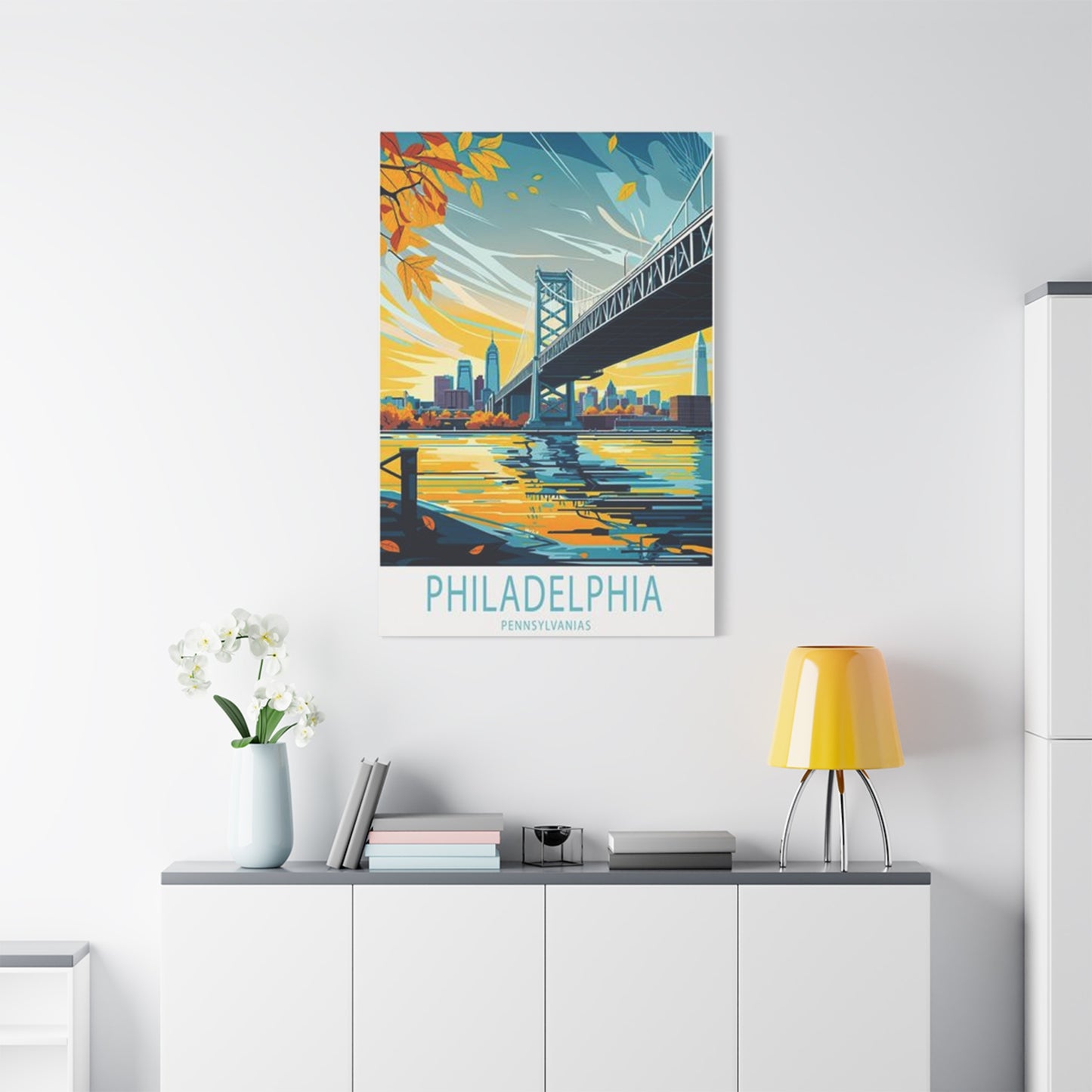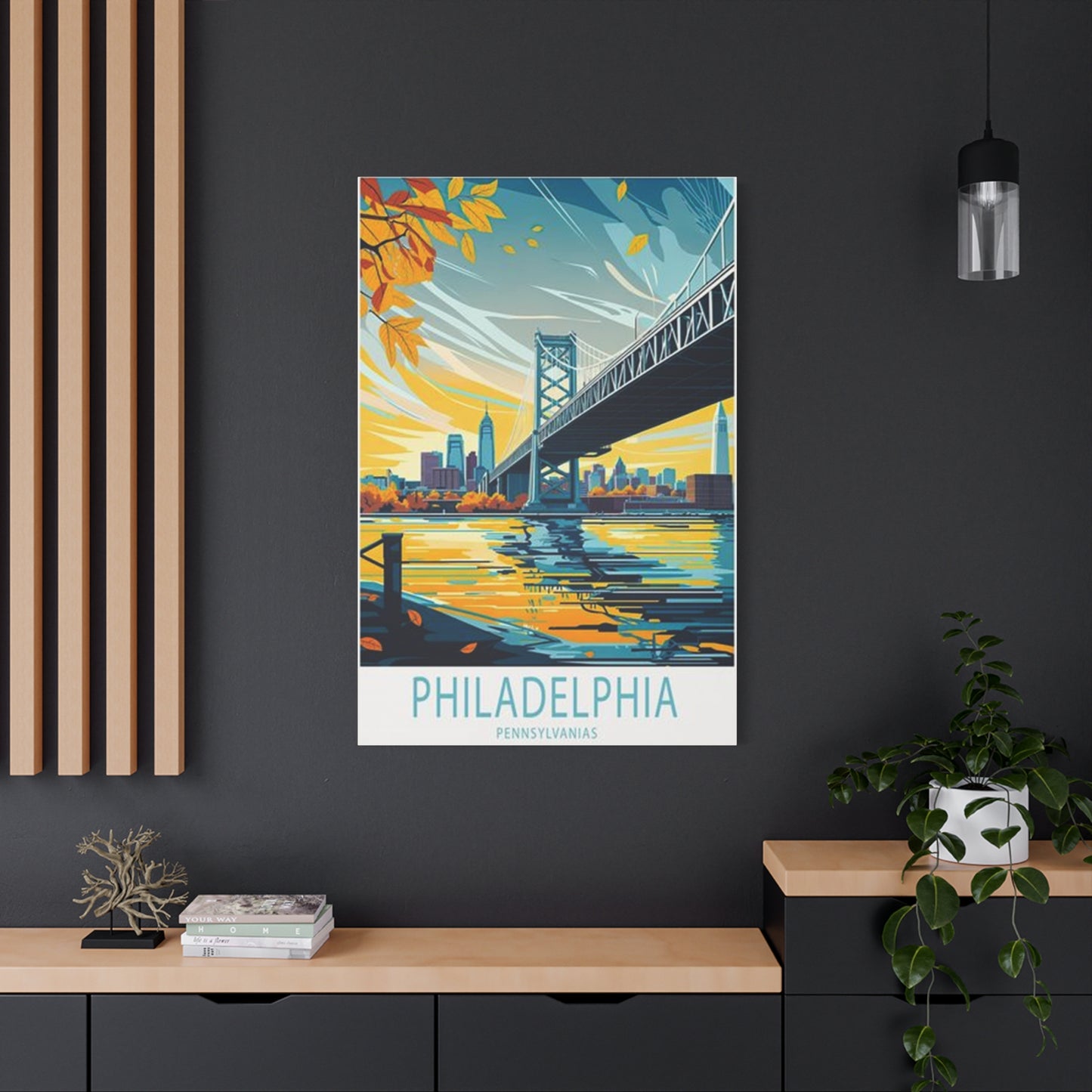Forging Aesthetics: Philadelphia Steel Bridge Wall Art and the Modern Industrial Home
Cities are living testaments to human ambition, and their skylines are the signatures of their character. Among the towering structures that define an urban landscape, bridges hold a unique and powerful place. They are not merely conveniences of transit; they are monumental sculptures, feats of audacious engineering, and powerful symbols of connection. In a city as steeped in history and industry as Philadelphia, the bridges that span the Delaware and Schuylkill rivers are more than just steel and rivets—they are the city's arteries and its most iconic landmarks. This raw, structural power has given rise to a potent and captivating genre of art: Philadelphia steel bridge art.
This form of artwork captures the intersection of heavy industry and refined aesthetics. It takes the massive, functional forms of structures like the Benjamin Franklin Bridge or the Walt Whitman Bridge and translates them into powerful statements for our interior spaces. In an age where home decor is increasingly leaning towards the authentic, the textured, and the meaningful, this art form offers a profound connection to a tangible piece of history. It is a celebration of the industrial charm that built the modern world, repurposed as a sophisticated element of design.
This exploration delves into the multifaceted world of Philadelphia's steel bridge art. We will examine why these images are more than just pictures, but rather visual narratives of strength, endurance, and urban elegance. From their role as the perfect keystone in an industrial-themed apartment to their surprising versatility in more traditional settings, we will uncover how these prints, posters, and photographs can fundamentally transform a room. This is the art of the engineered, the beauty of the functional, and the story of a city told through its most enduring steel giants.
The Striking Allure of Steel: Showcasing Philadelphia's Legendary Bridge Artwork
The concept of "beauty" in art is often associated with the delicate, the natural, or the classically harmonious. Yet, there exists a different, more visceral kind of allure found in the raw power of industrial forms. This is the beauty of steel, and nowhere is it more majestically captured than in artwork depicting the legendary bridges of Philadelphia. This art form celebrates the material itself—its texture, its strength, and its profound visual impact. It transforms colossal feats of engineering into intimate, personal statements of style and substance.
Steel, as an artistic subject, is inherently dramatic. It is a material of contrasts. It is rigid yet capable of spanning vast, open spaces with deceptive lightness, as seen in the graceful arc of a suspension cable. It is a man-made element, yet it interacts with the natural world in fascinating ways—reflecting the cold light of a winter morning, silhouetted against a fiery sunset, or disappearing into the ethereal mist rising from the river. Philadelphia steel bridge art harnesses this drama. Artists and photographers are drawn to the geometric complexity of the trusses, the rhythmic repetition of rivets, and the imposing presence of the towers that anchor these structures to the earth.
Philadelphia provides a particularly rich canvas. The city is a museum of American engineering, and its bridges are the star exhibits. The Benjamin Franklin Bridge, arguably the city's most recognizable span, is a masterpiece of early 20th-century design. Opened in 1926, its massive suspension towers and distinctive blue-green hue make it an endlessly fascinating subject. Art that features the "Ben Franklin" often focuses on its majestic scale, capturing the full span as it links Philadelphia to Camden, a ribbon of steel and light. Other interpretations dive deeper, finding abstract beauty in the intricate cross-bracing of its towers or the delicate web of its vertical suspender cables.
Then there is the Walt Whitman Bridge, another suspension giant with a different personality. It is less ornate than its northern neighbor, possessing a more muscular, mid-century functionalism. Artwork focusing on the Walt Whitman often emphasizes its sheer size and power, its wide deck a testament to the post-war boom in American mobility. Photographers capture the relentless flow of motion, the streams of light from cars at night creating a kinetic energy that contrasts with the static immovability of the steel structure itself.
We also find artistic inspiration in the city's other spans. The Tacony-Palmyra Bridge, a cantilevered truss and drawbridge, offers a different kind of mechanical beauty. Its complex lattice of steel beams creates a dense, intricate pattern that is a prime subject for black-and-white photography, where the focus is purely on form, line, and shadow. The Girard Avenue Bridge, with its historic, ornate details, tells a story of a different era, a time when even the most functional structures were imbued with decorative flair.
The "allure" mentioned in the heading is about this translation. How does a two-thousand-ton steel beam become an object of quiet contemplation on a living room wall? It happens through the artist's eye. By isolating a portion of the bridge, the artist frames the industrial as abstract art. The repeating triangles of a truss are no longer just structural support; they become a study in geometry. The weathered patina on a girder, with its subtle variations in color and texture, becomes as complex and interesting as a painter's canvas.
This artwork is a celebration of human ingenuity. These bridges were built by thousands of hands, representing a colossal collective effort. They were, and still are, symbols of progress, of connecting communities, and of conquering natural barriers. Owning a piece of Philadelphia bridge art is, in a small way, honoring that legacy. It's an appreciation for the vision it took to design these structures and the sheer physical labor it took to erect them.
Furthermore, the art serves as a powerful anchor of place. For a resident of Philadelphia, it is a proud emblem of home. For someone who has moved away, it is a nostalgic connection to the city's skyline. For a visitor or an admirer of urban landscapes, it is a symbol of American industrial might and architectural history. The beauty of steel, as captured in this art, is therefore complex. It is structural, historical, abstract, and deeply personal. It reminds us that function and form are two sides of the same coin, and that the most powerful art often comes from the most unexpected of places—not from a studio, but from the heart of the city itself, spanning a river with strength and grace.
The Ideal Fusion: Steel Bridge Artwork as a Keystone for Industrial-Themed Interiors
The industrial design aesthetic is born from a deep appreciation for the unadorned, the functional, and the authentic. It finds beauty in the raw materials and structural skeletons that other styles seek to conceal. Exposed brick, polished concrete floors, visible ductwork, reclaimed wood, and minimalist metal furniture are the hallmarks of this look. It is a style that values history, texture, and a sense of volume, often found in converted lofts, warehouses, or modern homes that emulate that spirit. Within this design language, finding the perfect focal point—the one element that ties all these raw textures together—can be a challenge. This is where Philadelphia steel bridge art finds its most natural and powerful application. It is not merely an accessory for industrial decor; it is a keystone.
A keystone, in architecture, is the central, wedge-shaped stone at the apex of an arch that locks all other pieces into position, bearing the weight and giving the structure its integrity. In an industrial-themed interior, a large-scale steel bridge print serves this exact function. It clarifies the room's narrative, connects the disparate elements, and provides a powerful, intentional focus that anchors the entire space. It is the piece that says, "This is not just a random collection of rustic and metal objects; this is a deliberate celebration of the engineered aesthetic."
The fusion is so ideal because the artwork speaks the same visual language as the decor. Industrial design is rooted in "material honesty." A steel bridge print is the epitome of this principle. It is an image that celebrates steel in its most raw, majestic, and functional form. The artwork doesn't shy away from the mechanics; it glorifies them. The print of a bridge's suspension tower, with its grid of massive bolts and plates, directly mirrors the design ethos of a cast-iron table base or a steel-framed bookcase. It reinforces the theme at a grander, more artistic level.
Consider the interplay of texture. An industrial space thrives on the contrast of rough and smooth, hard and soft. You might have the coarse, tactile quality of an old brick wall, the smooth coldness of a concrete countertop, and the warmth of a worn leather sofa. A steel bridge print introduces a visual texture that complements these physical ones. A high-resolution black-and-white photograph can capture the gritty, weathered surface of a steel girder, the precise, sharp lines of suspension cables, and the complex, overlapping planes of a truss. This visual depth prevents the minimalist and neutral palette of an industrial room from feeling flat or sterile.
Scale is another critical factor. Industrial-inspired spaces, such as lofts, often feature high ceilings and large, open-plan layouts. A small, delicate piece of art can be completely lost, dwarfed by the sheer volume of the room. Steel bridge prints, however, excel at a large, even monumental, scale. A six-foot-wide panoramic print of the Benjamin Franklin Bridge spanning the Delaware doesn't just occupy a wall; it commands it. It has the visual weight and presence necessary to stand up to the other strong elements in the room, like a heavy timber dining table or a large, sectional sofa. It becomes a window onto the urban industrial landscape that the design style itself seeks to honor.
Furthermore, the subject matter provides an essential narrative context. The industrial aesthetic is a nod to the Industrial Revolution and the manufacturing era that shaped our modern cities. What is a bridge if not the ultimate symbol of that era? It represents innovation, large-scale production, and the triumph of engineering. A print of a Philadelphia bridge, in particular, roots this general theme in a specific, tangible history. It connects the room to a real place, a city known for its manufacturing prowess and its foundational role in American industry. It adds a layer of soul and storytelling that a more generic abstract or a mass-produced "industrial" sign cannot.
In a practical sense, the color palette of these prints is a perfect match. Many of the most powerful bridge images are monochrome—stark black-and-white compositions. This aligns perfectly with the neutral, moody, and sophisticated color scheme of industrial design, which relies on shades of grey, black, brown, and white. The artwork adds drama and contrast without introducing competing colors, allowing the textures of the brick, wood, and metal to remain the stars.
Ultimately, steel bridge artwork is the ideal fusion for these interiors because it is an authentic echo of the room's core philosophy. It is not a contrived "factory-style" decoration; it is a genuine celebration of the "factory" itself—or in this case, the massive, city-scale machine that is a bridge. It’s the finishing touch that locks the entire aesthetic into place, providing a sense of history, power, and intentional design that defines the best industrial-themed spaces.
Philadelphia's Architectural Giants: Capturing the Spirit of Steel in Artwork
The city of Philadelphia is defined as much by its history as its striking modern-day silhouette. While landmarks like Independence Hall draw the eye to the past, the massive, elegant spans of its steel bridges anchor its presence firmly in the industrial age and the present. These engineering marvels are more than just transit corridors; they are breathtaking monuments to human ingenuity and enduring strength. This collection of steel structures—crossing the Schuylkill and Delaware rivers—has inspired a compelling, evocative genre of decorative art. The artistry inherent in their colossal frameworks, from the rhythmic pattern of their trusses to the geometric precision of their cables, translates seamlessly into powerful, emotionally resonant pieces for the home.
Embracing the aesthetics of these steel bridges in wall decor is a nod to urban history, architectural excellence, and a refined sense of industrial-meets-modern style. These artworks allow enthusiasts to bring a piece of Philadelphia's structural soul into their personal space, transforming a simple wall into a testament to architectural grandeur. The visual language of the steel truss, the cantilever, and the suspension cable offers a sophisticated counterpoint to softer home furnishings, creating a dynamic balance that is deeply appealing to contemporary design sensibilities. Furthermore, the inherent narrative—the connection, the span, the overcoming of a divide—adds a layer of meaning that goes beyond mere aesthetics, making this art form uniquely profound. The very essence of the city's pulse and persistence is captured in the shadows and lines of these metallic titans.
The Power of Metal: Prints of Steel Bridges Elevating Industrial Style
The aesthetic movement known as industrial-inspired decor thrives on raw materials, exposed structure, and utilitarian design elements, drawing heavily from the look of 19th and early 20th-century factories and infrastructure. Steel bridge prints are a definitive, perfect fit for this style, embodying its core principles with unparalleled authenticity and visual impact. The sheer materiality—the focus on the engineered structure of I-beams, rivets, and crisscrossed supports—lends itself flawlessly to the robust, unpolished character of industrial spaces. Unlike softer decorative elements, these prints provide a powerful focal point, often rendered in stark black and white or muted tones that emphasize texture, shadow, and form over color. This deliberate focus on structure aligns perfectly with the exposed brick, concrete floors, and visible ductwork typical of this design school. Incorporating a large-format steel bridge canvas or print immediately infuses a room with the necessary gravitas and historic weight that defines the style.
It's a celebration of function made beautiful, a cornerstone of the aesthetic. The geometric complexity of the bridge structures offers a sophisticated layer of visual interest, preventing the industrial look from becoming overly simplistic or monotonous. For homeowners seeking to master the industrial aesthetic, wall art depicting the massive, intricate frameworks of Philadelphia's notable crossings offers a direct, powerful, and unequivocally stylish route to achieving that coveted, authentic warehouse feel, all while paying tribute to structural artistry. The linear elements within the bridge designs create a sense of movement and depth, subtly guiding the viewer's eye through the architectural landscape. This kind of artwork doesn't just decorate a wall; it establishes the foundational character of the entire room's design narrative, speaking of resilience, construction, and enduring design principles.
Integrating Philadelphia's Urban Design into Interior Spaces
The desire to connect a personal living space with the vibrant energy and history of a city like Philadelphia often drives interior design choices. Incorporating images of the city's signature architecture, specifically its formidable steel bridges, is a sophisticated way to achieve this fusion. This art form acts as a portal, instantly transporting the viewer to the urban landscape, making the home feel grounded in a rich, geographic context. Beyond mere photographic representation, these artworks capture the monumental scale and meticulous detailing of the city's structural heritage. A framed print of a famous Philadelphia bridge, whether an imposing suspension bridge or a stout cantilever structure, serves as a powerful testament to the area’s engineering accomplishments. Designers often use these pieces to introduce a necessary element of contrast—the gritty, magnificent reality of urban construction juxtaposed against the curated comfort of a home.
This blending of the outdoor, massive environment with the indoor, intimate setting creates a captivating design tension. Furthermore, the selection of a specific bridge often holds personal significance for the resident, linking their dwelling not just to the city generally, but to a cherished memory or location within it. Choosing prints that feature the bridge during different times of day—perhaps shrouded in morning fog or lit dramatically against the night sky—allows for a range of moods to be introduced. This use of structural art is a deliberate and meaningful design statement, positioning the home as a curated extension of the great city itself, allowing the enduring spirit of Philadelphia's architecture to perpetually inform the domestic environment. It’s an exercise in bringing the monumental, public sphere into the personal, domestic sphere, enriching the latter with the narrative and scale of the former. This connection provides a sense of place that generic artwork simply cannot replicate, forging a deeper, more emotional attachment to the living space.
The Enduring Allure of Structural Steel Bridge Artwork
Few decorative themes possess the depth and versatility of steel bridge art, granting it a remarkable timeless appeal that transcends fleeting design trends. The basis of this enduring aesthetic lies in the fundamental principles of engineering and geometry—elements that are inherently classic and perpetually relevant. A bridge is, by its very nature, an object of purpose, an intersection of design and functionality, which gives its depiction in art a foundational, intellectual strength. The materials, often rendered in the stark, honest textures of steel, concrete, and rivet, speak to a permanence that is both historical and contemporary. Unlike art forms that rely heavily on specific color palettes or niche motifs, the dramatic lines and complex patterns of a steel truss provide a classic visual anchor that works with virtually any color scheme or furniture style.
Whether the print is a sharp, high-contrast photograph that emphasizes the structural integrity or a softer, atmospheric rendering that captures the play of light on metal, the subject matter itself remains universally compelling. Art featuring the iconic spans of Philadelphia maintains relevance because these structures are not just old buildings; they are active, dynamic parts of the modern infrastructure, symbolizing progress and connection. This blend of historic material and modern function ensures their continuous aesthetic currency. The inherent drama and sense of scale captured in these artworks give them a sophistication that ensures they will not quickly fade from favor, making them a wise, long-term choice for discerning decorators. This timeless appeal rests on the fact that steel bridges represent fundamental human achievements—the conquest of distance and the mastery of material science—qualities that resonate across all cultural and temporal boundaries, solidifying their status as an enduring artistic subject.
Steel Bridges as Decor Elements of Power and Steadfastness
In the realm of home decoration, the choice of art is never purely aesthetic; it is also profoundly symbolic, and the depiction of steel bridges carries a particularly potent symbolic charge. These structures are universally recognized as powerful metaphors for strength, resilience, stability, and connectivity. When incorporated into home decor, particularly as large-format wall art, they introduce an underlying narrative of unwavering endurance and purpose. The sight of massive steel supports, designed to withstand the relentless forces of nature and the passage of time and traffic, serves as a daily, silent affirmation of steadfastness. In a personal space, this translates into an atmosphere of solidity and confidence. Decorators often strategically place these images in communal areas to evoke a sense of grounding and architectural permanence. Beyond mere physical strength, bridges represent the ability to overcome obstacles, to link disparate points, and to foster connection.
This symbolism of 'bridging' divides—whether literal or metaphorical—adds a layer of positive, aspirational meaning to the artwork. The very metal from which Philadelphia's famous spans are built—strong, industrial-grade steel—carries associations of the Industrial Revolution, innovation, and enduring construction. Choosing a piece featuring these monumental steel works is a deliberate statement, signalling an appreciation for structural integrity and symbolic depth, imbuing the living space with a profound sense of rootedness and purposeful power. This deliberate use of symbolism elevates the decor from simple arrangement to thoughtful composition, contributing to a psychological landscape of stability and connection within the home. The visual weight and engineering logic of the bridge stand as a testament to reliability and the triumph of design over complexity, powerful concepts to integrate into one's daily environment.
Integrating Philadelphia Bridge Posters into Design
Styling a space effectively involves more than simply hanging a picture; it requires thoughtful consideration of scale, color, and context. Incorporating Philadelphia bridge posters into a design scheme offers a unique opportunity to blend urban aesthetics with personal style. The first step is to consider the print's relationship with the wall size. For a dramatic, architectural impact, choose a large-scale print that emphasizes the bridge's intricate geometric patterns, allowing the structure to dominate the visual field and act as the room's undisputed focal point. Conversely, smaller, series-based prints—perhaps a triptych showcasing different angles of the same iconic steel bridge—work well in hallways or as part of a curated gallery wall, introducing rhythm and narrative flow. The framing choice is equally crucial for complementing the aesthetic of the poster. A sleek, minimalist black or metallic frame enhances the industrial, architectural nature of the subject, keeping the focus squarely on the lines of the steel.
For a warmer, more traditional look, a simple wooden frame can soften the industrial edge while still maintaining the inherent dignity of the structure. In a room with an otherwise soft palette, the addition of a high-contrast black-and-white bridge poster injects necessary visual sharpness and depth. When styling a shelf or console beneath the art, use complementary materials like concrete, dark wood, or exposed metal accessories to echo the theme of the poster and create a cohesive, layered look. The key is to treat the Philadelphia bridge poster not just as decoration, but as a deliberate architectural element that anchors the room's design, tying together disparate pieces of furniture and décor through the common thread of urban elegance and structural beauty. This thoughtful integration ensures the artwork contributes meaningfully to the overall ambiance, rather than merely occupying wall space, allowing the spirit of the city’s engineering feats to permeate the surrounding decor.
Steel Bridges as Art in Contemporary Residences
Modern homes, characterized by clean lines, open spaces, and an emphasis on functional elegance, provide the perfect backdrop for the dramatic, structural beauty of steel bridges as art. This pairing is a celebration of urban elegance, where the industrial grit of the city's infrastructure is refined and presented in a sophisticated, minimalist context. In a contemporary residence, the intricate, linear elements of a bridge print serve as a compelling counterpoint to the generally smooth, unadorned surfaces of modern design. The bridge's complex geometry introduces an element of visual dynamism and texture that prevents minimalist spaces from feeling cold or sterile. For instance, a monochromatic print of a massive Philadelphia suspension bridge hung above a simple, low-slung sofa immediately elevates the entire living room, injecting a palpable sense of architectural scale and depth.
The artwork acts as a conceptual anchor, giving the otherwise sparse room a strong, identifiable point of reference. The very nature of steel bridges aligns with modern principles: they are built for efficiency, strength, and streamlined function—qualities highly valued in contemporary design philosophy. Using these images is a subtle yet powerful way to incorporate the energy of the metropolis without sacrificing the polished look of a modern home. It's a method of decorating that speaks to a discerning taste, one that appreciates engineering as high art. The sophisticated interplay of light and shadow on the steel cables and girders, often captured in this art, transforms a simple wall into a window onto the majestic complexity of the urban built environment, solidifying the home’s status as a space of thoughtful, contemporary design. This aesthetic choice bridges the gap between the purely functional and the purely decorative, embodying a modern sensibility that finds beauty in utility and structure.
Philadelphia’s Crossings: A Testament to Structural Legacy in Art
The bridges spanning the rivers of Philadelphia are more than just functional thoroughfares; they are integral chapters in the city’s narrative, embodying a profound legacy in steel and art. Each structure, from the Benjamin Franklin Bridge to the smaller, equally vital railroad trestles, tells a story of industrial growth, engineering prowess, and the determination to connect communities. Capturing these historical and infrastructural monuments in artwork is a way of preserving and celebrating this enduring legacy. When a piece of art depicts one of these iconic steel bridges, it is not merely an image of metal and concrete; it is a visual record of a major civic endeavor. The artwork becomes a tribute to the thousands of workers, engineers, and designers whose collective effort resulted in these colossal, elegant structures.
Incorporating this type of art into a home introduces a piece of genuine historical and geographic context. It grounds the interior space in the significant heritage of the region, offering a deeper conversation starter than abstract art might. This deep connection to a city's formative moments is what gives Philadelphia's bridges their unique power as artistic subjects. The materials themselves—the oxidized steel and the weathered stone piers—add a layer of authentic patina and historical weight to the artwork. For those who appreciate history and engineering, these images serve as a constant reminder of the city's ambition and its enduring impact on American infrastructure. The artistic representation of these bridges ensures that their story—the complex intersection of civic necessity and structural beauty—continues to be told, celebrating the indelible legacy in steel that defines a significant part of the Philadelphia skyline.
Embracing the Industrial Charm of Steel Bridge Wall Art
The distinct appeal of industrial charm in home decor often lies in the acceptance and celebration of imperfection, authenticity, and the rugged beauty of materials. Steel bridge wall art perfectly embodies this ethos, capturing the true character of structures that are constantly exposed to the elements. Unlike art that strives for idealized perfection, bridge prints often find their beauty in the visible signs of time: the texture of aged steel, the patterns of rust, the massive, exposed rivets, and the purposeful, sometimes rough, connections of the truss work. This focus on the raw, unpolished nature of the material provides an immediate and powerful injection of industrial charm into any space.
A photograph that highlights the heavy shadows and stark geometry of a Philadelphia trestle bridge can transform a plain wall into a dynamic feature, anchoring the room with its visual weight and material honesty. The very subject matter—a massive, functional structure—is inherently antithetical to frivolous decoration, lending the art an air of seriousness and permanence. This type of wall art works exceptionally well in lofts, repurposed factory spaces, or any home looking to achieve a genuine, non-fussy aesthetic. By featuring the authentic wear and tear of a steel bridge, the artwork communicates a deep appreciation for the beauty found in utility and robust construction, allowing the underlying character of the architecture to become the main decorative feature. It’s an embrace of the 'beautifully brutal,' where the structure's purpose is its primary form of elegance, contributing a genuine, unforced layer of industrial charm to the interior landscape.
From Engineering Feat to Home Focal Point: Steel Bridges as Applied Art
The journey of a steel bridge from a complex engineering marvel to a celebrated element of home decor represents a fascinating transition in applied aesthetics. These structures are fundamentally solutions to a technical problem—spanning a distance—yet their elegant symmetry and massive scale render them inherently artistic. The act of commissioning or purchasing art depicting these structures is an acknowledgment that the principles of functional engineering often align with the principles of beautiful design. Art prints that focus on the repeating geometric patterns of a truss, the perfect parabolic curve of a suspension cable, or the monumental solidity of a pier celebrate the design work as much as the construction. By framing and hanging a print of one of Philadelphia's great steel crossings, a homeowner is essentially treating the work of civil engineers as a form of sculptural art.
This theme, from engineering marvel to home decor, underscores the intellectual component of the artwork, appealing to those who appreciate the intersection of logic and beauty. It transforms the cold, hard logic of structural physics into a warm, contemplative piece of interior design. Furthermore, the immense size and complexity of a bridge often compel the viewer to consider scale and structure in a new light, bringing a sense of architectural grandeur into the intimate setting of a home. This is a sophisticated way of decorating that moves beyond simple aesthetics to celebrate human ingenuity and the enduring beauty found in functional design. The visual strength of the image provides a permanent, intellectual anchor within the room, serving as a daily reminder of how form truly follows function, but often with spectacular artistic results.
Steel Bridge Art: A Modern Industrial Must-Have
In the world of interior design, industrial aesthetics continue to reign supreme, blending raw materials, bold structures, and a sense of urban sophistication. Steel bridge art has become an essential feature of this design style, bringing a fusion of engineering marvel and artistic expression into modern spaces. The intricate details of steel bridges, like the ones in Philadelphia, not only evoke the power and resilience of these structures but also add a unique artistic flair to any room.
Steel bridge wall art makes a statement. The geometric forms, intricate lines, and contrasting textures make it a bold choice for walls, especially in spaces designed to highlight urban sophistication. Whether displayed in a loft apartment, modern office, or contemporary living room, it immediately catches the eye and sets the tone for the entire space. It speaks to the strength and beauty of steel as a material, transforming an ordinary wall into a piece of art that embodies the industrial spirit.
This type of wall art works particularly well in open-concept spaces with high ceilings and expansive walls. It adds dimension and depth while complementing other industrial design elements, such as exposed brick, metal accents, and concrete flooring. The steel bridges’ bold, structural form also serves as a great focal point when paired with minimalistic furniture or neutral tones, enhancing the raw, untamed beauty of industrial design.
Not only does steel bridge art exude strength, but it also tells a story—one of engineering innovation, urban development, and architectural prowess. It allows homeowners and designers to showcase their appreciation for both art and architecture, making it more than just a décor choice but a celebration of modern industrial culture. For anyone looking to incorporate a piece of history and artistry into their industrial-style home, steel bridge art is undoubtedly a modern must-have.
Philadelphia Bridges: Perfect for Industrial Interiors
Philadelphia’s steel bridges are more than just transportation structures—they’re architectural masterpieces that embody the industrial era's spirit. As symbols of strength, functionality, and aesthetic beauty, these bridges have become iconic features of the city’s skyline and are now a staple in modern industrial interior design.
Incorporating Philadelphia bridge art into industrial interiors creates a seamless connection between urban history and contemporary design. The city’s bridges, like the Ben Franklin and Walt Whitman bridges, are not just essential pieces of infrastructure but visual landmarks. Their bold, geometric lines, robust steel structures, and intricate details speak to the raw, industrial charm that defines modern urban design. When these bridges are translated into art, they bring a sense of history and a rugged, authentic vibe into any space.
Philadelphia bridge art works particularly well in industrial homes and spaces with raw elements like exposed brick, concrete floors, and metallic accents. The steel textures of the bridges mirror the industrial materials used in these spaces, creating a harmonious balance between form and function. This kind of art becomes a focal point on a large wall or a dramatic centerpiece in a minimalist living area.
Moreover, Philadelphia’s rich history as an industrial hub further enriches the narrative behind the artwork. Each bridge tells a story of progress, engineering excellence, and the city’s role in shaping America’s urban and economic landscape. By incorporating these bridges into interior design, you’re not just adding art to your home—you’re connecting with the industrial heritage that helped build the nation’s cities.For those looking to infuse their industrial interiors with character and history, Philadelphia bridge art is the perfect choice, blending functionality with aesthetic appeal. It’s a tribute to the city’s past while celebrating its modern-day urban landscape.
Why Steel Bridge Wall Art Works in Urban Spaces
Urban spaces are known for their eclectic mix of contemporary design, modern architecture, and raw, industrial elements. Steel bridge wall art is the perfect addition to these environments, effortlessly complementing the high-energy, dynamic nature of city living. Whether in a loft apartment, a downtown office, or a trendy café, steel bridge art enhances the industrial chic vibe that defines urban spaces.
One of the main reasons steel bridge art works so well in urban environments is its ability to capture the essence of city life—strength, progress, and resilience. The industrial feel of steel bridges mirrors the raw, unpolished quality of many urban settings. The bold, geometric shapes and intricate details of the bridges add a layer of visual interest to a room, drawing the eye and sparking conversation. They evoke the sense of a city’s architecture, where steel and concrete dominate the skyline, and offer a direct connection to the urban landscape.
Furthermore, the combination of steel and art offers a balanced contrast to the softer elements often found in urban interiors. Steel’s cold, industrial feel is tempered by its transformation into a beautiful piece of art, making it ideal for spaces that embrace a balance of hard and soft, old and new. The artwork can soften the harshness of an industrial space while still maintaining its gritty charm.
In addition to its aesthetic appeal, steel bridge art can provide a sense of continuity and connection. Urban spaces are constantly evolving, with construction, redevelopment, and growth shaping the cityscape. Steel bridge art represents this constant progress and change, serving as a visual reminder of the city’s ever-changing nature while adding a timeless element to the design.For anyone looking to elevate their urban space with bold, meaningful décor, steel bridge wall art is an ideal choice that blends seamlessly with modern city living.
Industrial Elegance: Adding Bridge Art to Your Home
Industrial design often evokes a sense of raw, unfinished beauty, where materials like steel, concrete, and exposed brick are showcased in their most natural forms. But what if you could add an element of sophistication and elegance to this rugged aesthetic? Bridge art, particularly pieces featuring steel structures like those from Philadelphia, offers the perfect way to blend industrial rawness with a refined touch of elegance.
The elegance in steel bridge art lies in its balance. While the intricate details and strong geometric lines speak to the industrial aesthetic, the carefully designed compositions add a layer of beauty and sophistication. The way light interacts with steel textures, the play of shadows, and the grandeur of the bridges evoke an understated luxury that enhances the industrial theme without overwhelming it.
Adding bridge art to your home introduces a narrative of progress and engineering mastery. The history embedded in these structures brings a sense of timelessness and artistry to the space. Whether placed in a living room, dining area, or even an entryway, bridge art serves as a conversation starter, turning your walls into an elegant display of urban history and modern design.
Steel bridge art is versatile enough to complement various interior styles within the industrial genre. It pairs beautifully with dark furniture, neutral colors, and sleek, minimalistic accessories. The boldness of the steel contrasts against softer furnishings and gives the room a sense of balance. Moreover, the large, expansive shapes of bridge art make it a perfect fit for open-concept spaces with high ceilings.For anyone seeking to elevate their industrial home with a touch of class and sophistication, steel bridge art offers a way to do so with style, elegance, and a nod to modern architecture.
The Allure of Philadelphia Steel Bridges in Design
Philadelphia’s steel bridges are more than just functional structures; they are architectural icons that represent the spirit of innovation, strength, and urban growth. As centers of movement and connectivity, these bridges connect people and places, making them a symbol of unity and progress. When these bridges are captured in art, their allure extends beyond their engineering prowess and taps into the aesthetic power they hold.
The allure of Philadelphia’s steel bridges lies in their historical and architectural significance. These structures are designed to withstand the test of time, and their intricate details speak to the technical brilliance that went into their creation. The combination of strength, symmetry, and scale makes them not just functional pieces of infrastructure, but also visually compelling works of art. These bridges serve as perfect subjects for wall art, capturing the essence of urban development and the dynamic nature of the city itself.
When integrated into home design, Philadelphia bridge art brings a sense of history and character to the space. Its bold lines and geometric forms create visual interest, while its connection to the city’s rich past imbues the room with a sense of place and identity. Whether displayed in a living room, office, or hallway, the art becomes more than just decoration—it becomes a part of the room’s story.
Incorporating these bridges into design not only enhances the industrial vibe but also pays homage to Philadelphia’s role in shaping America’s urban landscape. For anyone looking to celebrate both modern architecture and historical beauty, Philadelphia steel bridge art offers the perfect way to do so with timeless appeal.
Steel and Style: How Bridge Art Elevates Your Space
Steel bridge art is more than just an aesthetic choice; it’s a powerful design tool that can transform a room. The combination of industrial strength and artistic elegance in steel bridge art adds depth, dimension, and a unique sense of style to any space. Whether you're designing a home, office, or commercial space, incorporating bridge art can elevate the environment, creating a bold focal point that speaks to both architectural beauty and modern sensibilities.
The beauty of steel bridge art lies in its versatility. The geometric, industrial forms of the bridge are balanced by their artistic execution, transforming a raw, functional structure into a visually striking piece of art. This transformation allows the art to fit seamlessly into various design styles, from minimalist to maximalist, while still maintaining a strong, urban presence. Whether you’re looking to soften the edges of a concrete-heavy room or emphasize the boldness of a modern industrial space, steel bridge art provides the perfect balance of strength and beauty.
Moreover, steel bridge art offers a sense of narrative that enriches a space. It tells the story of engineering innovation, urban development, and the power of human ingenuity. When displayed on your wall, it creates an immediate conversation starter, inviting viewers to explore the history behind the image. This layer of storytelling adds depth to the design, turning your space
Conclusion:
The extensive exploration of Philadelphia's architectural giants, particularly its magnificent steel bridges, reveals a powerful and sophisticated trend in modern interior design. The appeal of this subject matter—from its inherent industrial charm to its powerful symbolism of strength and connection—is multifaceted and enduring. Bridge art is far more than a decorative accessory; it is a statement piece that roots a home in the rich history and structural ambition of a major American city.The twenty themes we have discussed, spanning from styling advice to the deep symbolism embedded in the steel itself, underscore the versatility of this art form. We’ve seen how prints of these colossal structures seamlessly integrate into both the rugged honesty of industrial decor and the polished simplicity of contemporary, urban homes.
Whether rendered in dramatic black-and-white to emphasize line and shadow, or in rich color to capture the texture of weathered metal, the final product remains a testament to both engineering marvel and aesthetic excellence.The continuous relevance of these art pieces is due to their connection to fundamental human concepts. They represent stability, the overcoming of obstacles, and the elegant, complex geometry of human ingenuity. By selecting a high-quality print of an iconic Philadelphia bridge, a homeowner is introducing a visual narrative of permanence and aspiration into their personal space.
It is a way to celebrate the aesthetic intersection of art and engineering, transforming the functionality of a civic structure into a focal point of personal expression. The enduring allure of the city's legacy in steel ensures that this art form will not fade, but will continue to provide a sophisticated, intellectually engaging, and deeply stylish foundation for interior design for years to come. This art is a permanent invitation to appreciate the grandeur and structural grace that define the modern urban landscape. The decision to incorporate these monumental images is an elegant choice, signifying a deep appreciation for design that is both historically significant and arrestingly contemporary, solidifying the trend of using architectural giants as sophisticated domestic muses.



















